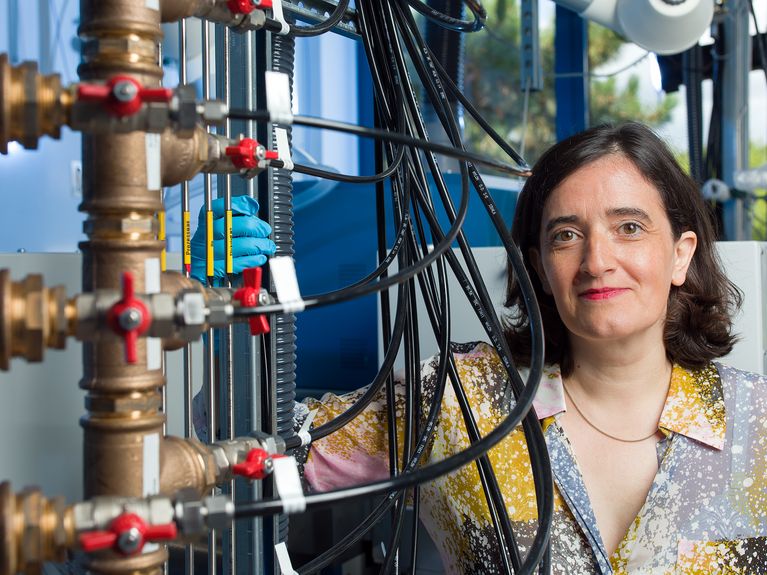Porträt
"Berlin is a wonderful place for my research"

Prof. Dr. Catherine Dubourdieu. Image: HZB
The physicist Catherine Dubourdieu is researching high-tech materials to make future computer generations and quantum computers more energy-efficient. In Berlin, she commutes between three different locations.
This one picture is the focal point in her apartment: a large oil painting in bright colours, especially the red stands out against the white wall, and in the abstract a person can be recognised on it. "I love painting," says Catherine Dubourdieu and points to the picture, "a great painting, isn't it?" She gave it to herself when she recently turned 50, the artist comes from near Toulouse. "For me, it means a piece of France in my living room," she says with a smile.
The physicist has chosen a strategic location for this living room. She lives in Wilmersdorf, in the middle of western Berlin, and she has the distances precisely in her head: it takes her 15 minutes from here to Freie Universität Berlin, where she gives seminars at the Institute of Chemistry via a special professorship, and 30 minutes to the Helmholtz-Zentrum Berlin (HZB) in Berlin-Adlershof, where she takes measurements at the synchrotron source BESSY II. And 30 minutes to Wannsee, the second location of HZB, where her own high-tech laboratories are located – she has set up a highly specialised synthesis and analysis chamber cluster there.
The fact that Catherine Dubourdieu works in so many places is due to the complexity of her field of research: She needs the most diverse research methods, and the technology for this is distributed over the various locations. She is working on "functional oxides for energy-efficient information technology" - her institute also bears this somewhat unwieldy name. It is a tinkering work that is the focus of her research: if thin layers of different metal oxides are stacked on top of each other, sandwich structures are created – and these often have completely different properties than their starting materials. These new materials can form the basis for components that will be used in computers or sensors in the future. One vision is to use them to replace conventional silicon computer devices. For example, topologically protected states in nanoscale ferroelectric materials hold promise for novel ultra-compact memories. Another example concerns the optimization of metal oxide nanoscale devices that mimic the behavior of our brain synapses in order to develop neuromorphic computing.
This highly complex work is taking place at the boundary between nanotechnology, materials science and physics, and at yet another boundary: that between basic and applied research. "I don't just want to deal with the fundamentals," says Catherine Dubourdieu, and when she talks about her work, you can hear her delight in craftsmanship: "growing, designing and engineering materials” – these are the three terms she uses to describe what happens behind her laboratory doors. Then comes understanding their properties and finally integrating the new materials in real devices. When the new materials are ready for use one day, they are expected to save enormous amounts of energy in computers, computer centers and in all electronic appliances.
Catherine Dubourdieu has ten patents, a clear sign of her strong practical orientation. "For me, a patent counts as much as a publication," she says. 17 people are working in her team, and she is currently expanding it. It is this infrastructure of skilled colleagues and high-tech equipment at HZB that attracted the Frenchwoman to Berlin four and a half years ago: She has her alma mater in Grenoble, for research stays in the USA she was first in New Jersey and later at IBM's research centre in New York state. She came to Germany thanks to the Helmholtz recruitment initiative. "Berlin is a great place for my research," she enthuses: The three large universities and the numerous research institutes formed a dense network that could only be found in a few cities worldwide. She is currently helping to build an important part of this infrastructure herself: The Helmholtz Energy Materials Foundry (HEMF), where state-of-the-art laboratories for materials synthesis are being built that can also be used by external researchers. All this, she says, speaks for Berlin – not to mention, she adds with a smile, the international flavor of a capital, the numerous green spots, and the museums and galleries..
Catherine Dubourdieu looks at the clock, soon she has to leave her apartment: her colleagues at the photon source BESSY II are just starting new investigations – “we have beam time there all week, today we're starting. One of her research colleagues from France is involved, another one from Berlin. It promises to be a full week for Catherine Dubourdieu.
Helmholtz General Assembly
On 12.10.2020 from 14:00 to 16:00 o'clock the Helmholtz General Assembly takes place. This year it will be virtual, at three locations and open to everyone. Among other things, it will focus on how quantum technologies are changing our world. Catherine Dubourdieu will also be a guest. Further information and the complete program can be found behind the following link:
Readers comments